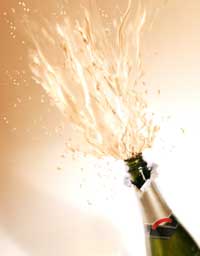Putting the fizz into physics! Inspire article
Lucy Attwood from Oxford Danfysik, UK, explains the mysterious appeal of champagne.

Champagne, champagne, champagne. It has launched a thousand ships, toasted countless exam results, witnessed millions of proposals and, I’m pretty sure, initiated an innumerable number of headaches!
People have celebrated with champagne (the sparkling wine accidentally discovered in the Champagne region of France) since the 17th century. Practically everybody I know loves it because of its fabulous fizz, and most associate the beverage’s quality with the size and quantity of its characteristic bubbles.
So where do the bubbles come from?
During the fermentation process of wine manufacture, yeast reacts with grape sugar to produce alcohol and carbon dioxide gas. In standard wine production, the gas is released, but when producing sparkling wine, the gas is instead trapped under pressure inside the bottle. There it remains, dissolved in the liquid, until a suitably special occasion dictates that the cork should be ceremoniously popped.
Once open, the higher concentration of carbon dioxide in the wine than in the atmosphere results in an imbalance, which reaches equilibrium through the formation of bubbles; bubbles that escape from the liquid until balance is restored. Bubbles, bubbles, bubbles – adding sparkle for the eye and tingle for the tongue.
The bubbles don’t just form anywhere, however; they are triggered at points in the glass or bottle where there is a microscopic defect such as a scratch or dust particle. The irregularity, known as a nucleation point, prompts carbon dioxide molecules to come out of solution and create a bubble. The bubble expands as more molecules diffuse into it from the surrounding liquid, which has a much higher concentration of carbon dioxide.
Once the bubble is big enough to have acquired sufficient buoyancy, it detaches from the nucleation point and rises to the surface. Alone again, the irregularity grabs more carbon dioxide molecules from the liquid and another bubble is formed, and another, and so on until you have a steady stream of bubbles rising vertically through your drink.
So next time you’re at a party and somebody hands you a rather expensive-looking flute of fizzy champagne, remember… it’s probably just a dirty glass!
Try it at home
You can easily demonstrate the formation of bubbles at nucleation sites using salt. The surface of a salt grain is covered with microscopic flaws, which make perfect gathering places for carbon dioxide molecules. Dropping a little salt into a glass of champagne creates hundreds of new nucleation sites, resulting in an impressive display of sparkle.
Important warning: using champagne for this experiment is extremely dangerous and could result in severe damage to the bank balance. Under no circumstances should champagne be used for this demonstration; instead, use beer or another carbonated beverage!





